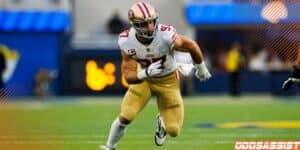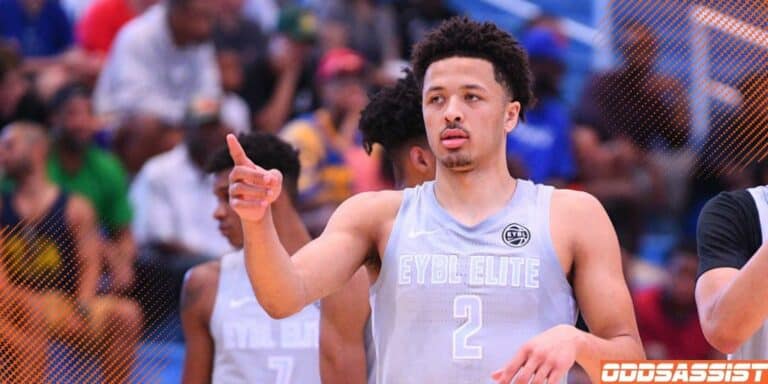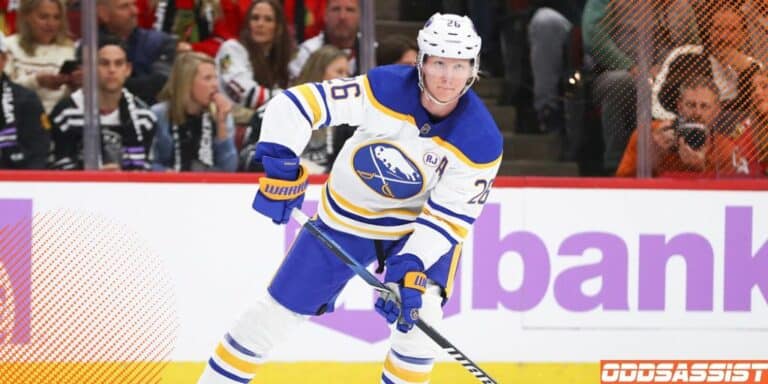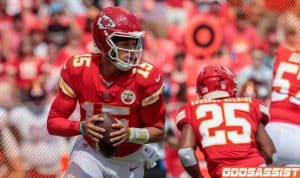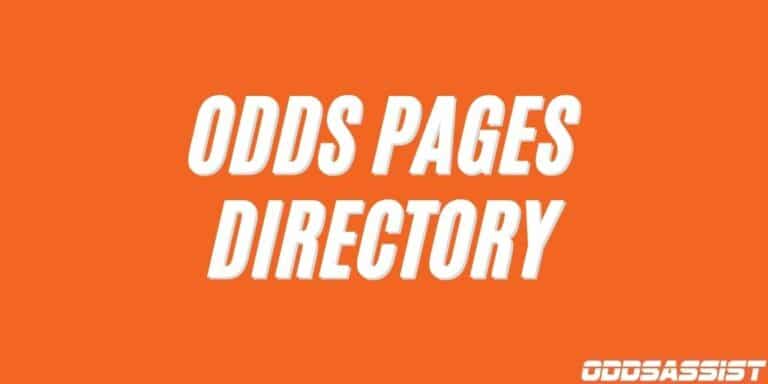Companies featured on this page may be our partners who compensate us if you sign up for one through our links. This doesn't affect our ratings or opinions in any way. Must be 21+. Gambling Problem? Call 1-800-GAMBLER. See full disclosure.
Point spread betting is the most common type of sports bet in the United States.
When you bet the point spread, you simply choose a team plus or minus a certain number of points that they must win or lose less than by (often called “covering the spread”).
For example, if you bet the Chiefs -6.5, they must win by 7 points or more for your bet to win. If you bet the Dolphins +6.5, on the other hand, they must either win or lose by less than 7 points.
A positive spread means that the team is the underdog while a negative spread means that it is the favorite.
Spread betting is common in many sports, such as football, basketball, baseball (“run line”), and hockey (“puck line”).
The 3 Outcomes of a Spread Bet
There are three main outcomes of a spread bet: win, lose, or push.
Let’s go through each with an example wager: a bet on the Eagles (-3) against the Cowboys (+3):
- Win: Your bet wins if the Eagles win by 4 points or more (such as Eagles 24 & Cowboys 17). You can calculate your winnings with our Betting Odds Calculator.
- Lose: Your bet loses if the Eagles win by less than 3 points or lose outright (such as the Eagles 23 & Cowboys 21 or the Eagles 17 & Cowboys 21.
- Push: Your bet pushes if the Eagles win exactly 3 points (such as the Eagles 24 & Cowboys 21).
What happens if your bet pushes?
In this case, you are refunded your exact wager amount. If you bet $30 and it pushes, you receive the $30 back. You don’t win or lose any money in this scenario.
Offers from our partners
How to Read Point Spreads
Now that we’ve gone over the basics of spread betting, let’s quickly touch on how to read a point spread.
When you’re looking at lines, you will always see the two teams with opposite numbers next to them. One will be positive (the underdog) while the other will have the same number, but it will be negative (the favorite).
Here’s a look at an example from the FanDuel Sportsbook:

In this example, the Clippers are the favorite and must win by 6 to push or 7 to cover the spread. The Mavericks are the underdogs and must win outright or lose by less than 6 to cover the spread.
To actually say what the lines are out loud, you would say, “The Clippers are minus 6 against the Mavericks” or “The Clippers are 6-point favorites against the Mavericks.” On the other side, you would say “The Mavericks are plus 7 against the Clippers” or “The Mavericks are 7-point underdogs against the Clippers.”
The other numbers under the spreads (-104 & -118 in the example above) are the current odds. These will typically vary between -105 to +120 for football and basketball but -110 is the standard.
The reason that most odds are -110 or another close negative number—as opposed to just +100—is that the sportsbook charges a “vig” or “juice” in order to take your bet. This is how they make money.
To learn more about what these numbers mean, check out our guide to how to read betting odds or article on what +200 and -200 mean in sports betting.
What ‘pick em’ or PK means in spread betting
If you ever see “PK” listed as a spread, it simply means there is no favorite. This is called a “pick ‘em” and is essentially just choosing which side will win the game.
The odds for the PK spread bet and the moneyline bet (which is simply which team will win the game with no spread) should be the same in this case.
How the Half-Point Works in Spread Betting
The half-point that is sometimes included in a spread (such as +7.5, +3.5, or -5.5) is called “the hook.”
When there is a hook, there is no way for the bet to push since you can’t score half points in spread betting sports.
Instead, you know exactly how many points your team has to win by or lose less than by.
Let’s take a look another example game from FanDuel:

In this game between the Lakers (-1.5) and the Suns (+1.5), there are only two outcomes for each team: win or lose.
The Lakers spread bet wins if the Lakers end up winning by 2 points or more.
The Suns spread bet wins if the Suns win the game or lose by 1 point.
Why the hook is important to pay attention to
Even though a half-point may not seem like a lot, it can make a big difference in a game—especially when it comes to football.
The most common result of NFL games is for a team to win by 3 points.
If you are betting on the favorite, it would be much better to get that favorite at -3 points than it would be to get them at -3.5 points. In the latter scenario, your team would have to win by 4 points which is much less common than winning by 3. If you got the team at -3, the result would be a push if the game ended on the most common margin of victory (3 points).
If you are betting on the underdog, on the other hand, getting +3.5 points would be preferable to +3 points because losing by a field goal (again, the most common margin of victory/defeat), would result in a win as opposed to a push if the spread were only +3.
Key numbers in football—which reflect the next most common margins of victory—are 3, 7, and 10. Other less important key numbers are 6, 4, and 14.
Some bettors choose to bet alternate spreads, which allow them to move the spread in exchange for a higher or lower payout depending which direction they move them to. For example, if the standard spread is -3, someone may “buy the hook” by moving the line to -3.5 in exchange for a lower payout/worse odds.
Why Spreads Change Leading Up to Game Time
The exact way that sportsbooks come up with lines is outside of the scope of this article, but it’s important to know that lines often change between the time they are first released (the “opening lines”) and when the game starts (“closing lines”).
Sportsbooks mostly change lines based on the bets they take on those games.
For example, let’s say the Bills open as 3.5-point underdogs against the Patriots, with both lines having odds of -110. When the lines are released, the majority of money starts coming in on the Bills +3.5.
The first thing that would likely happen is that the sportsbook would start shifting the odds to encourage more bets on the Patriots. For example, the Bills +3.5 may go to -115 while the Patriots -3.5 goes to -105. Since -105 has a bigger payout than -115, some bettors may decide to bet on the Patriots.
If most of the money keeps coming in on the Bills, the sportsbook may move the line as opposed to just the odds. In this example, the book may move the Bills from +3.5 to +3—a less favorable bet for Bills spread bettors.
It’s important to look at lines when they first open and throughout the week so you can try getting the best lines and odds possible. If the NFL lines open on Tuesday, for example, and you think that there’s a good chance the Bills +3.5 moves to +3 over the course of the week, it would be smart to get your bet in before it does move.
You can figure out if you made a good spread bet by comparing your line and odds to the line and odds that the game “closed” at (a.k.a. the lines and odds right before the game starts). If you bet the Bills +3.5 at -110 odds and the game closes at Bills +3 and -110, you theoretically made a good bet. This is called closing line value.
Run Line & Puck Line Spread Betting
If you’re looking at lines in certain sportsbooks, you may see the “run line” for baseball games or “puck line” for hockey games.
These still work just like spread bets in football or basketball, they just often have a wider range of accompanying odds. Also, since baseball and hockey games are often decided by one run or goal, the spread is set to 1.5 by default.
Instead of moving the run line or puck line in these games to account for the chances of each team covering the spread, sportsbooks almost always just change the odds.
For example, take a look at these MLB lines from the DraftKings Sportsbook:
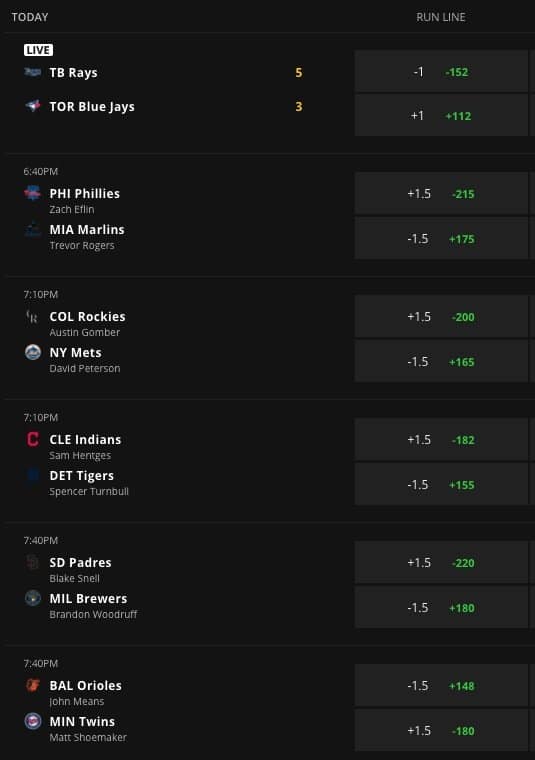
As the image shows, the run lines vary well outside of the -105 to -120 range we often see in football and basketball but the lines are all +/- 1.5.
FAQs on Betting the Point Spread
What is against the spread (ATS)?
A team’s record against the spread works just like a normal record except that it is how many times they’ve covered the spread (first digit) and haven’t covered the spread (second digit).
For example, if the Bears cover the spread in their first game, then don’t cover the spread in the next three games, they would be 1-3 against the spread.
What is a push in spread betting?
A push occurs when the result of the game lands exactly on the spread. For example, if the Giants are -3 and win by exactly 3 points, the game would be a “push” and bettors would receive the money they wagered back.
What does Pick ‘em or PK mean?
A game is a Pick ‘em when there is no favorite and the spreads are between -0.5 and +0.5. In pick ‘em games, the team that wins the game would also be the winner of the spread bet.
What do -7 and +7 mean in sports betting?
A spread of -7 means that that team must win by over 7 points to cover while a spread of +7 means that the team must win or lose by less than 7 points to cover. If a spread is -7 and the team wins by 7, the bet would be a push.
What do -3 and +3 mean in sports betting?
A spread of -3 means that that team must win by over 3 points to cover while a spread of +3 means that the team must win or lose by less than 3 points to cover. If a spread is +3 and the team loses by 3, the bet would be a push.
What do -3.5 and +3.5 mean in sports betting?
A spread of -3.5 means that that team must win by 4 points or more to cover while a spread of +3.5 means that the team must win or lose by 3 points or less to cover. There is no possibility for a “push” in this situation since teams cannot score a half-point.
Why are point spreads so much higher in college football than in the NFL?
There is a much larger disparity in the skill level of college football teams than there is with NFL teams. The average margin of victory of college football games is much higher than that of NFL games, meaning that the spreads are also much larger.
What are first half and first quarter spreads?
In addition to betting the spread of the whole game, most sportsbooks allow you to bet on the spread of quarters and halves such as the first quarter, first half, or second half. There is no difference in how spreads work when betting on quarters or halves as compared to the spread on an entire game. There are also double result bets in which you parlay the results of the first half and final score.
How are point spreads are determined?
Sportsbooks use vast amounts of data, in-depth research, and complex algorithms to determine point spreads. Many sportsbooks also simply copy other “market-making sportsbooks” to set their lines. Once a line opens, sportsbooks will also change spreads and odds based on the bets that customers place on that game.
What are winning margin spread bets?
With winning margin bets, you choose which team will win and by which predetermined point range. For example, you may be able to choose the Eagles to win by 1 to 6 points, 7 to 13 points, or 14 to 20 points.
What is point shaving?
Point shaving is when a player or multiple players on a team that is favored purposefully mess up to make sure the underdog covers the spread. In exchange, they are paid money but the person who setup the scheme, who places bets on the underdog so they make money.
>> Read More: What does +2.5 mean in sports betting?

